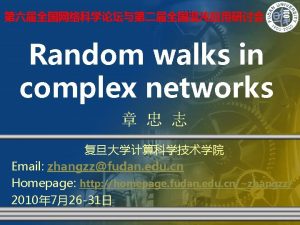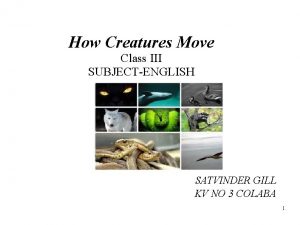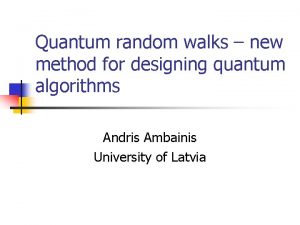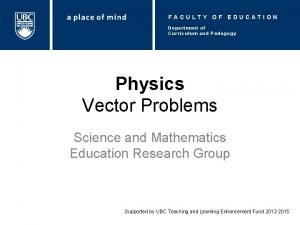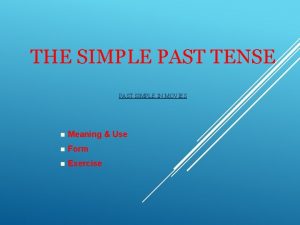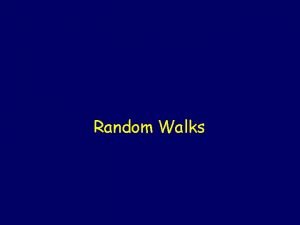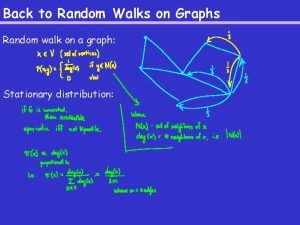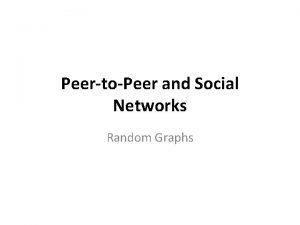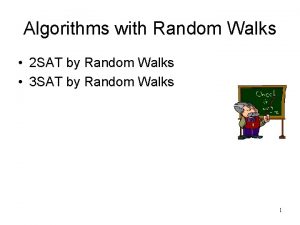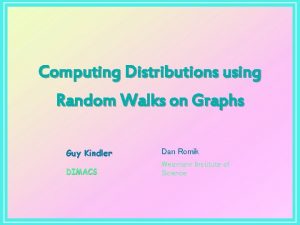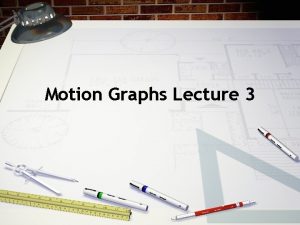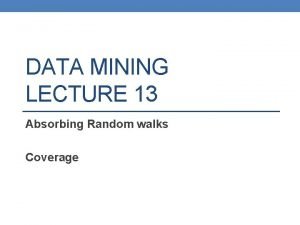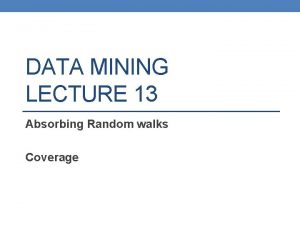Seminar on random walks on graphs Lecture No




![Reversible Markov Chains (cont. ) Theorem [HAG 6. 1]: let be a Markov chain Reversible Markov Chains (cont. ) Theorem [HAG 6. 1]: let be a Markov chain](https://slidetodoc.com/presentation_image_h/ac85eb4120f58210de2455a33c35a220/image-5.jpg)


















- Slides: 23

Seminar on random walks on graphs Lecture No. 2 Mille Gandelsman, 9. 11. 2009

Contents • Reversible and non-reversible Markov Chains. • Difficulty of sampling “simple to describe” distributions. • The Boolean cube. • The hard-core model. • The q-coloring problem. • MCMC and Gibbs samplers. • Fast convergence of Gibbs sampler for the Boolean cube. • Fast convergence of Gibbs sampler for random qcolorings.

Reminder A Markov chain with state space is said to be irreducible if for all we have that . A Markov chain with transition matrix is said to be aperiodic if for every there is an such that for every : Every irreducible and aperiodic Markov chain has exactly one stationary distribution.

Reversible Markov Chains • Definition: let be a Markov chain with state space and transition matrix. A probability distribution is said to be reversible for the chain (or for the transition matrix) if for all we have: • Definition: A Markov chain is said to be reversible if there exists a reversible distribution for it.
![Reversible Markov Chains cont Theorem HAG 6 1 let be a Markov chain Reversible Markov Chains (cont. ) Theorem [HAG 6. 1]: let be a Markov chain](https://slidetodoc.com/presentation_image_h/ac85eb4120f58210de2455a33c35a220/image-5.jpg)
Reversible Markov Chains (cont. ) Theorem [HAG 6. 1]: let be a Markov chain with state space and transition matrix . If is a reversible distribution for the chain, then it is also a stationary distribution. Proof:

Example: Random walk on undirected graph denoted by is a Markov chain with state space: and a transition matrix defined by: It is a reversible Markov chain, with reversible distribution: Where:

Reversible Markov Chains (cont . ) Proof: if and are neighbors: Otherwise:

Non-reversible Markov chains At each integer time, the walker moves one step clockwise with probability and one step counterclockwise with probability . Hence, is (the only) stationary distribution.

Non-reversible Markov chains ( cont. ) The transition graph is: According to the above theorem it is enough to show that is not reversible, to conclude that the chain is not reversible. Indeed:

Examples of distributions we would like to sample Boolean cube. The hard-core model. Q-coloring.

The Boolean cube dimensional cube is regular graph with vertices. Each vertex, therefore, can be viewed as tuple of -s and -s. At each step we pick one of the possible directions and : ◦ With probability : move in that direction. ◦ With probability : stay in place. For instance:

The Boolean cube (cont. ) What is the stationary distribution? How do we sample?

The hard-core model Given a graph each assignment of 0 -s and 1 -s to the vertices is called a configuration. A configuration is called feasible if no two adjacent vertices both take value 1. Previously also referred to as independent set. We define a probability measure on as follows, for : Where is the total number of feasible configurations.

The hard-core model (cont. ) An example of a random configuration chosen according to in the case where is the a square grid 8*8:

How to sample these distributions? Boolean cube - easy to sample. Hard-core model: There are relatively few feasible configurations, meaning that counting all of them is not much worse than sampling. But: , which means that even in the simple case of the chess board, the problem is computationally difficult. Same problem for q-coloring…

Q-colorings problem For a graph and an integer we define a q-coloring of the graph as an assignment of values from with the property that no 2 adjacent vertices have the same value (color). A random q-coloring for is a qcoloring chosen uniformly at random from the set of possible q-colorings for . Denote the corresponding probability distribution on by .

Markov chain Monte Carlo Given a probability distribution that we want to simulate, suppose we can construct a MC , whose stationary distribution is . If we run the chain with arbitrary initial distribution, then the distribution of the chain at time converges to as . The approximation can be made arbitrary good by picking the running time large. How can it be easier to construct a MC with the desired property than to construct a random variable with distribution directly ? … It can ! (based on an approximation).

MCMC for the hard-core model Let us define a MC whose state space is given by: , with the following transition mechanism - at each integer time , we do as follows: ◦ Pick a vertex uniformly at random. ◦ With probability : if all the neighbors of take the value 0 in then let: Otherwise: ◦ For all vertices other than :

MCMC for the hard-core model (cont. ) In order to verify that this MC converges to: we need to show that: ◦ It’s irreducible. ◦ It’s aperiodic. ◦ is indeed the stationary distribution. We will use theorem proved earlier and show that is reversible.

MCMC for the hard-core model (cont. ) Denote by the transition probability from state to . We need to show that: for any 2 feasible configurations. Denote by the number of vertices in which and differ: ◦ Case no. 1: ◦ Case no. 2: ◦ Case no. 3: because all neighbors of must take the value 0 in both and - otherwise one of the configurations will not be feasible.

MCMC for the hard-core model – summary If we now run the chain for a long time , starting with an arbitrary configuration, and output then we get a random configuration whose distribution is approximately

MCMC and Gibbs Samplers Note: We found a distribution that is reversible, though it is only required that it will be stationary. This is often the case because it is an easy way to find a stationary distribution. The above algorithm is an example of a special class of MCMC algorithms known Gibbs Samplers.

Gibbs sampler A Gibbs sampler is a MC which simulates probability distributions on state spaces of the form where and are finite sets. The transition mechanism of this MC at each integer time does the following: ◦ Pick a vertex uniformly at random. ◦ Pick according to the conditional distribution of the value at given that all other vertices take values according to ◦ Let for all vertices except .
 The man of integrity walks securely
The man of integrity walks securely Random walks
Random walks Speed and velocity
Speed and velocity Graphs that enlighten and graphs that deceive
Graphs that enlighten and graphs that deceive 5-3 practice polynomial functions
5-3 practice polynomial functions What is state graph in software testing
What is state graph in software testing 01:640:244 lecture notes - lecture 15: plat, idah, farad
01:640:244 lecture notes - lecture 15: plat, idah, farad Random assignment vs random sampling
Random assignment vs random sampling Random assignment vs random selection
Random assignment vs random selection Walks talent management
Walks talent management Who walks on padded paws
Who walks on padded paws Quantum walks
Quantum walks Why does miss caroline punish scout
Why does miss caroline punish scout Quinton typically walks 28 yards south
Quinton typically walks 28 yards south Steve walks from point p to point q
Steve walks from point p to point q She walks in beauty figurative language
She walks in beauty figurative language She walks in beauty by lord byron
She walks in beauty by lord byron Bible verse guard your heart with all diligence
Bible verse guard your heart with all diligence Past simple movies
Past simple movies She walks in beauty like the night meaning
She walks in beauty like the night meaning He who walks with the wise grows wise
He who walks with the wise grows wise Walks near inverurie
Walks near inverurie A woman walks into a hospital clutching her abdomen
A woman walks into a hospital clutching her abdomen Jazz walk
Jazz walk

